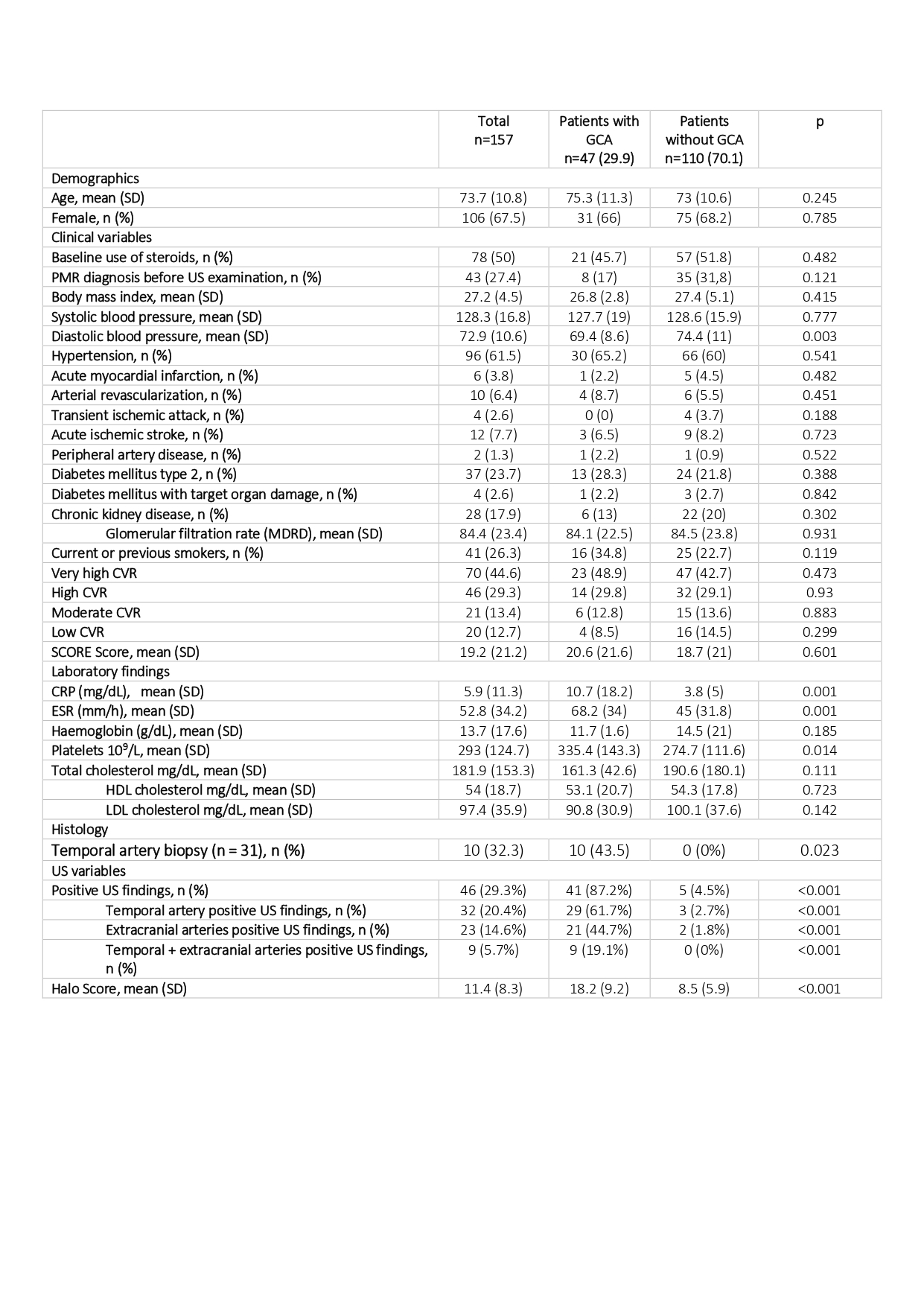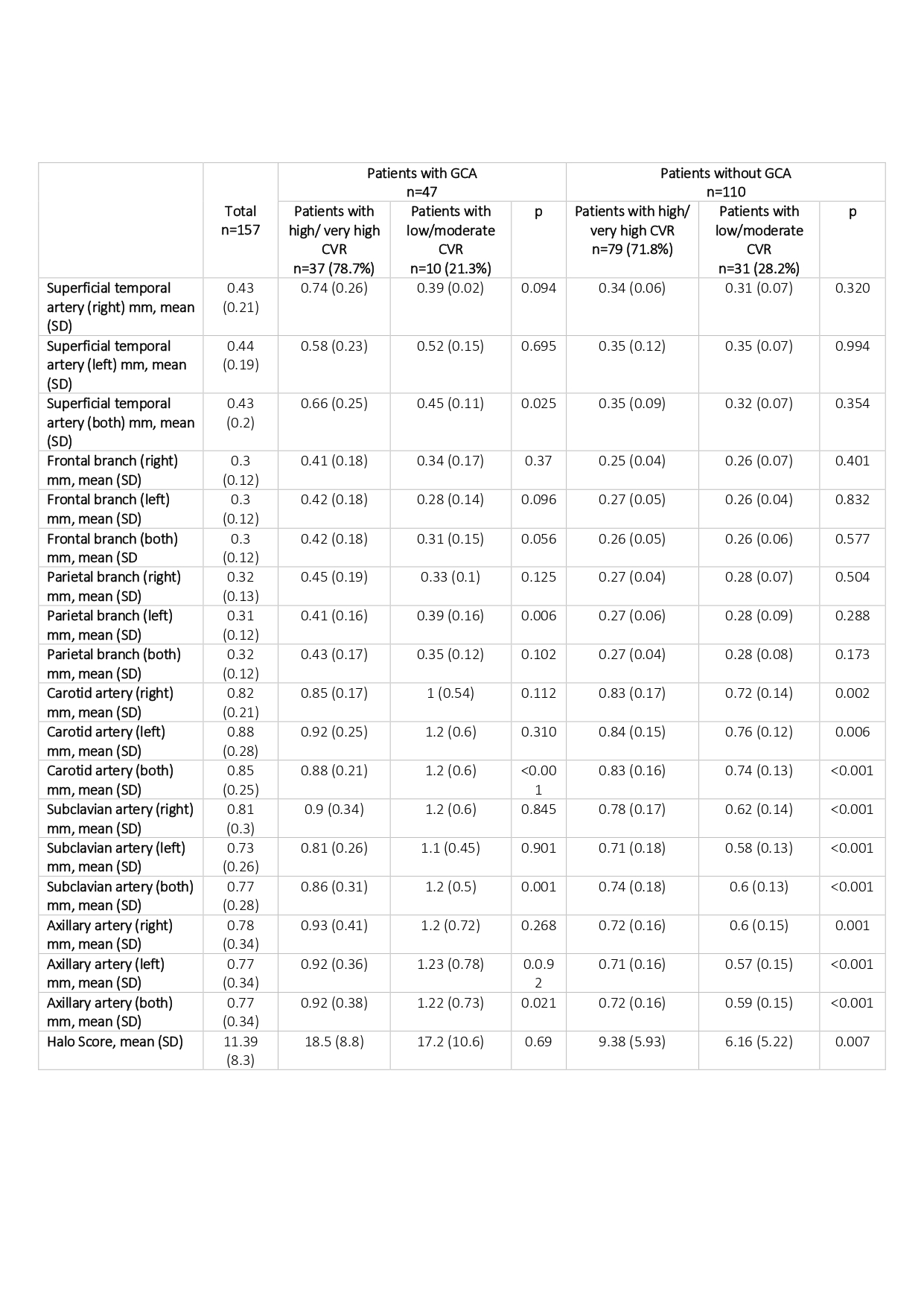Back
Ignite Talk
Session: Ignite Session 3A
1263: Impact of Cardiovascular Risk on the Diagnostic Accuracy of the Ultrasound Halo Score for Giant Cell Arteritis
Sunday, November 13, 2022
9:05 AM – 9:10 AM Eastern Time
Location: Northern Liberties Stage

Juan Molina-Collada, MD
Hospital General Universitario Gregorio Marañón
Madrid, SpainDisclosure: Disclosure information not submitted.
Ignite Speaker(s)
Juan Molina1, KATERINE FABIOLA LOPEZ GLORIA2, Isabel Castrejon3, Juan Carlos Nieto González1, Julia Martinez-Barrio1, Ana M Anzola Alfaro4, Javier Rivera4 and José María Älvaro-Gracia1, 1Hospital General Universitario Gregorio Marañón, Madrid, Spain, 2Department of Rheumatology, Hospital General Universitario Gregorio Marañón, Madrid, Spain, Madrid, Spain, 3Hospital Universitario Gregorio Marañón, Madrid, Spain, 4Department of Rheumatology, Hospital General Universitario Gregorio Marañón, Madrid, Spain
Background/Purpose: To evaluate the impact of cardiovascular risk (CVR) on the diagnostic accuracy of the ultrasonographic (US) Halo Score in patients with suspected giant cell arteritis (GCA)
Methods: Retrospective observational study of patients referred to our US fast track clinic with suspected GCA for a 2-years period. The intima media thickness (IMT) of cranial and extra-cranial arteries and the Halo Score was determined to assess the extent of vascular inflammation. The European Society of Cardiology Guidelines on CV Disease Prevention were used to define different categories of CVR and patients were classified according to the Systemic Coronary Risk Evaluation (SCORE). The gold standard for GCA diagnosis was clinical confirmation after 6-month follow-up.
Results: Of the 157 patients included, 47(29.9%) had GCA after 6-month follow-up. Baseline characteristics of patients are shown in Table 1. Extra-cranial artery IMT was significantly higher in patients with high/very high CVR than in those with low/moderate CVR, but only among patients without GCA. Non-GCA patients with high/very high CVR had also a significantly higher Halo Score in contrast with low/moderate CVR [9.38(5.93) vs 6.16(5.22); p=0.007] (Table 2). The area under the ROC curve of the Halo Score to identify GCA was 0.835 (CI95% 0.756-0.914), slightly greater in patients with low/moderate CVR (0.965 [CI95% 0.911-1]) versus patients with high/very high CVR (0.798 [CI95% 0.702-0.895]) (Figure 1). A statistically weak positive correlation was found between the Halo Score and the SCORE (r 0.245;p=0.002).
Conclusion: Elevated CVR may influence the diagnostic accuracy of the US Halo Score for GCA. Thus, CVR should be taken into consideration in the US screening for GCA.
 Table 1. Clinical, laboratory variables, and US findings in patients with or without GCA.
Table 1. Clinical, laboratory variables, and US findings in patients with or without GCA.
Abbreviations: GCA: giant cell arteritis; PMR: polymyalgia rheumatica; CRP: C-reactive protein; ESR: erythrocyte sedimentation rate; US: ultrasound; HDL: high density lipoprotein; LDL: low density lipoprotein; SD: standard deviation
 Table 2. Measurements of IMT in cranial and extracranial arteries and Halo Score values according to CVR. SD: standard deviation
Table 2. Measurements of IMT in cranial and extracranial arteries and Halo Score values according to CVR. SD: standard deviation
 Figure 1. Diagnostic accuracy of the Halo Score for a clinical diagnosis of GCA after 6 months follow-up in (A) all LVV suspected patients, (B) patients with high to very high CVR and (C) patients with low to moderate CVR. Youden index was used to determine the optimal cut-off points. AUC, area under the curve, LR+, positive likelihood ratio; LR−, negative likelihood ratio; ROC, receiver operating characteristic; Sens, sensitivity; Spec, specificity
Figure 1. Diagnostic accuracy of the Halo Score for a clinical diagnosis of GCA after 6 months follow-up in (A) all LVV suspected patients, (B) patients with high to very high CVR and (C) patients with low to moderate CVR. Youden index was used to determine the optimal cut-off points. AUC, area under the curve, LR+, positive likelihood ratio; LR−, negative likelihood ratio; ROC, receiver operating characteristic; Sens, sensitivity; Spec, specificity
Disclosures: J. Molina, None; K. LOPEZ GLORIA, None; I. Castrejon, None; J. Nieto González, None; J. Martinez-Barrio, None; A. Anzola Alfaro, None; J. Rivera, None; J. Älvaro-Gracia, None.
Background/Purpose: To evaluate the impact of cardiovascular risk (CVR) on the diagnostic accuracy of the ultrasonographic (US) Halo Score in patients with suspected giant cell arteritis (GCA)
Methods: Retrospective observational study of patients referred to our US fast track clinic with suspected GCA for a 2-years period. The intima media thickness (IMT) of cranial and extra-cranial arteries and the Halo Score was determined to assess the extent of vascular inflammation. The European Society of Cardiology Guidelines on CV Disease Prevention were used to define different categories of CVR and patients were classified according to the Systemic Coronary Risk Evaluation (SCORE). The gold standard for GCA diagnosis was clinical confirmation after 6-month follow-up.
Results: Of the 157 patients included, 47(29.9%) had GCA after 6-month follow-up. Baseline characteristics of patients are shown in Table 1. Extra-cranial artery IMT was significantly higher in patients with high/very high CVR than in those with low/moderate CVR, but only among patients without GCA. Non-GCA patients with high/very high CVR had also a significantly higher Halo Score in contrast with low/moderate CVR [9.38(5.93) vs 6.16(5.22); p=0.007] (Table 2). The area under the ROC curve of the Halo Score to identify GCA was 0.835 (CI95% 0.756-0.914), slightly greater in patients with low/moderate CVR (0.965 [CI95% 0.911-1]) versus patients with high/very high CVR (0.798 [CI95% 0.702-0.895]) (Figure 1). A statistically weak positive correlation was found between the Halo Score and the SCORE (r 0.245;p=0.002).
Conclusion: Elevated CVR may influence the diagnostic accuracy of the US Halo Score for GCA. Thus, CVR should be taken into consideration in the US screening for GCA.
 Table 1. Clinical, laboratory variables, and US findings in patients with or without GCA.
Table 1. Clinical, laboratory variables, and US findings in patients with or without GCA.Abbreviations: GCA: giant cell arteritis; PMR: polymyalgia rheumatica; CRP: C-reactive protein; ESR: erythrocyte sedimentation rate; US: ultrasound; HDL: high density lipoprotein; LDL: low density lipoprotein; SD: standard deviation
 Table 2. Measurements of IMT in cranial and extracranial arteries and Halo Score values according to CVR. SD: standard deviation
Table 2. Measurements of IMT in cranial and extracranial arteries and Halo Score values according to CVR. SD: standard deviation Figure 1. Diagnostic accuracy of the Halo Score for a clinical diagnosis of GCA after 6 months follow-up in (A) all LVV suspected patients, (B) patients with high to very high CVR and (C) patients with low to moderate CVR. Youden index was used to determine the optimal cut-off points. AUC, area under the curve, LR+, positive likelihood ratio; LR−, negative likelihood ratio; ROC, receiver operating characteristic; Sens, sensitivity; Spec, specificity
Figure 1. Diagnostic accuracy of the Halo Score for a clinical diagnosis of GCA after 6 months follow-up in (A) all LVV suspected patients, (B) patients with high to very high CVR and (C) patients with low to moderate CVR. Youden index was used to determine the optimal cut-off points. AUC, area under the curve, LR+, positive likelihood ratio; LR−, negative likelihood ratio; ROC, receiver operating characteristic; Sens, sensitivity; Spec, specificityDisclosures: J. Molina, None; K. LOPEZ GLORIA, None; I. Castrejon, None; J. Nieto González, None; J. Martinez-Barrio, None; A. Anzola Alfaro, None; J. Rivera, None; J. Älvaro-Gracia, None.

